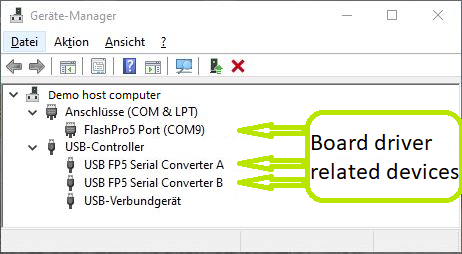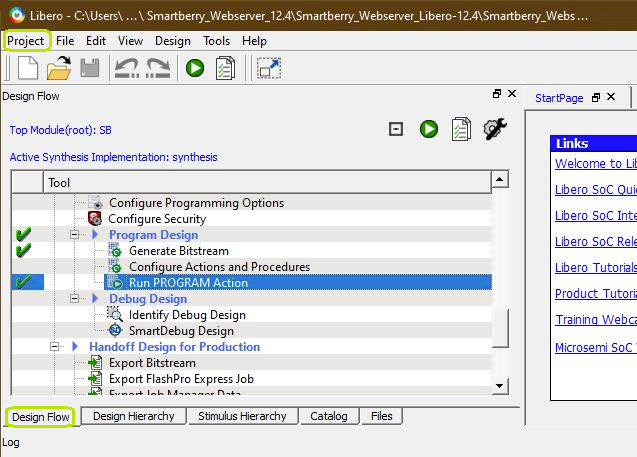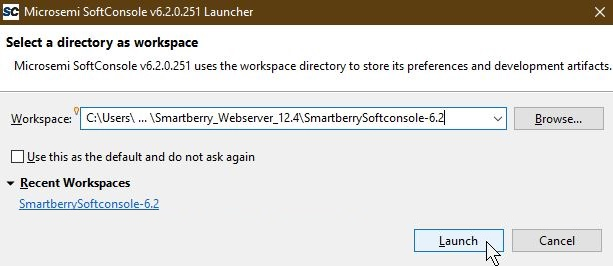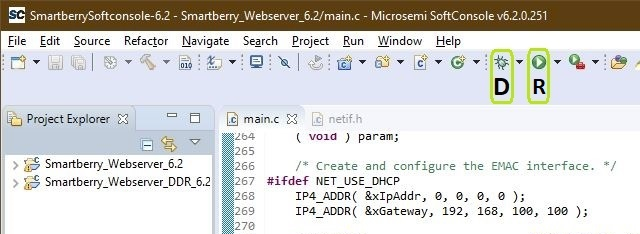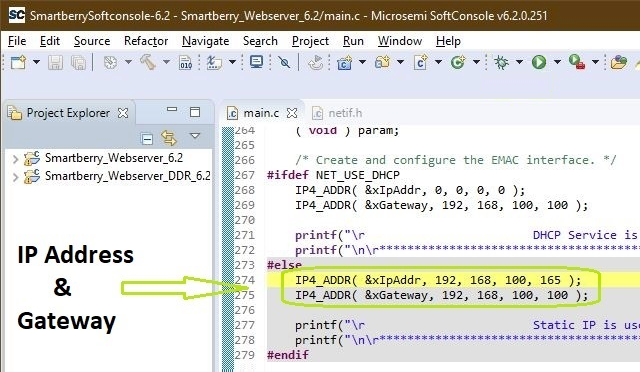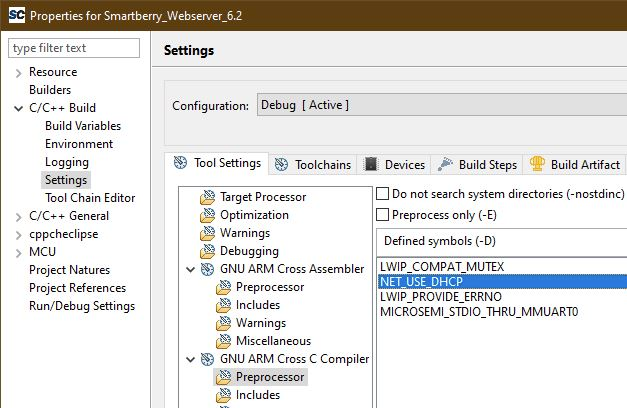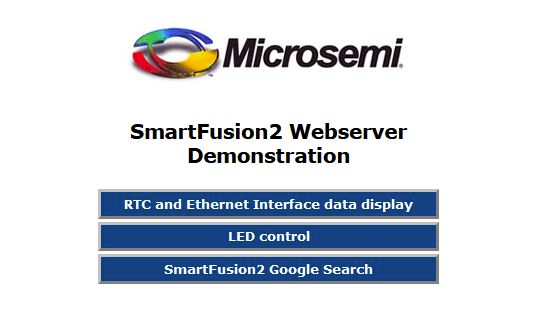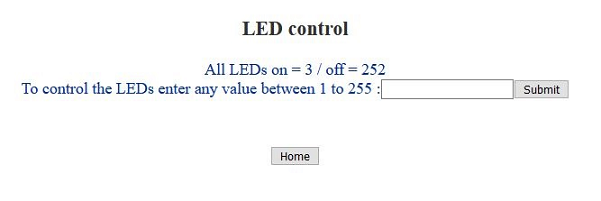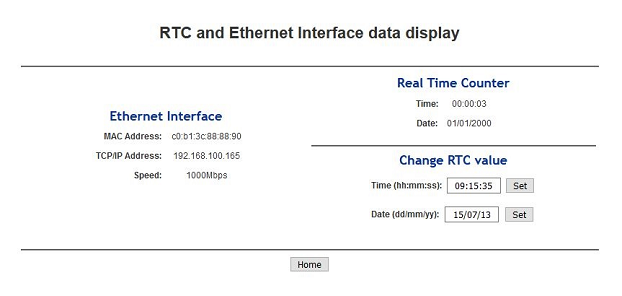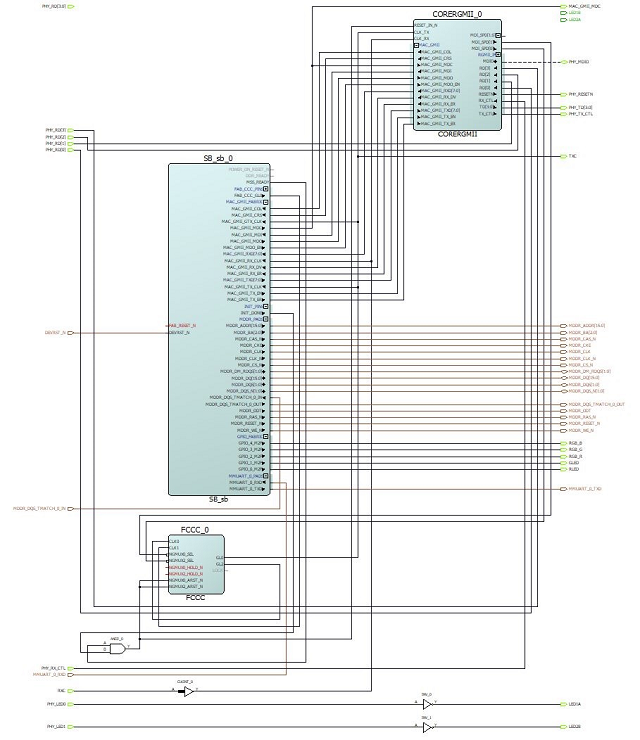Table of contents
Overview
This demo is a Webserver which utilizes SmartFusion2 SoC ARM Cortex-M3, Ethernet, USB / COM-port, Real Time Clock and the on-board LEDs.
The demo is offered in two variants, one which is stored into the embedded non-volatile memory (eNVM) and the other executed from the external DDR3/L SDRAM memory.
Refer to http://trenz.org/tem0002-info for the current online version of this manual and other available documentation.
Key Features
- Libero 12.4 (FPGA IDE)
- SoftConsole 6.2 (Software IDE)
- FreeRTOS V7.0.1 (Free real time operating system)
- lwIP 1.4.1 (lightweight IP)
- ETH
- UART
- DDR
- eNVM
- User LED access
- Real Time Clock
Revision History
| Date | Libero | Project Built | Authors | Description |
|---|---|---|---|---|
| 2020-09-xy | 12.4 | TEM0002-SmartBerry_Webserver-Demo_Libero-12.4_2020.10.05-1320.zip | Kilian Jahn |
|
| 2018-02-26 | 11.8 | Smartberry_Webserver_Demo.zip | -- |
|
Release Notes and Know Issues
| Issues | Description | Workaround/Solution | To be fixed version |
|---|---|---|---|
| No known issues | --- | --- | --- |
Requirements
Software
| Software | Version | Note |
|---|---|---|
| Windows 10 | 2004 / 19041 | |
| FTDI Driver | 2.12.28.0 | |
| Libero Release | 12.4 | SoftConsole 6.2 is included into the Libero installation |
| Microsemi Flash Pro 5 Board driver | 2.10.0.0 | Utilize onboard programmer and USB / comport connection |
| Web browser | Any ordinary Web browser to access the demos Web server |
Hardware
Design supports following modules:
| Module Model | Board Part Short Name | PCB Revision Support | DDR | embedded SRAM | embedded Flash | Notes |
|---|---|---|---|---|---|---|
| TEM0002-01-010C | SmartBerry | REV01 | 1 GBit / 128 MB | 64 kB | 256 kB | NA |
Hardware Requirements:
| Additional Hardware | Notes |
|---|---|
| Demo host computer | Demo was created and tested on windows |
| SmartBerry board | |
| Micro USB to USB Type A Cable | Power supply over USB. Programming the board. Communication Interface with the board. |
| ETH cable | Ethernet configured to use DHCP. Configuration for use of a static IP possible. |
| Lan to USB / Router | Optional HW for accessing the Web server |
Content
Content of the zip archive:
- Libero Hardware Project
- SoftConsole Workspace, containing:
Software Project - Smartberry_Webserver_6.2
Software Project - Smartberry_Webserver_DDR_6.2
Board configuration file - Manual (This wiki page as PDF)
Design Sources
| Type | Location | NotesRevision History |
|---|---|---|
| Libero | <TEM0002-SmartBerry_Webserver-Demo_Libero-12.4_2020.10.05-1320> /Smartberry_Webserver_Libero-12.4 | Libero Project |
| SoftConsole | <TEM0002-SmartBerry_Webserver-Demo_Libero-12.4_2020.10.05-1320> /SmartberrySoftconsole-6.2 /Smartberry_Webserver_6.2 /Smartberry_Webserver_DDR_6.2 | SoftConsole Workspace Contains two variants of the demo:
|
Download
Reference Design is only usable with the specified Libero/SoftConsole version. Usage of a different Microsemi Software versions is not recommended.
Reference Design is available on:
Design Flow
The reference design is available as a prebuild zip archive, which contains a Libero hardware project folder, a SoftConsole Workspace with the 2 variants of the demo and the board configuration file "microsemi-smartfusion2-smartberry-ddr.cfg". It was created and tested in windows environment.
Move the board configuratiion file to ... .
Copy board file:
board-file = microsemi-smartfusion2-smartberry-ddr.cfg
C:\Microsemi\SoftConsole_v5.1\openocd\share\openocd\scripts\board\board-file
Launch
Connecting
USB and Ethernet
Connect the boards Ethernet port to your demo host computer. The demo is configured to establish a network connection via the DHCP protocol, therefore a free router / network port can be used.
A direct port to port connection between the demo host computer and the board is also possible but requires to reconfigure the software project.
Driver check
Connect the board via USB cable to your demo host computer. Check in the Windows Device Manager the appearance of the tree board driver related devices:
- FlashPro5 Port (ComX)
- USB FP5 Serial Converter A
- USB FP5 Serial Converter B
The Device Manager is accessible via "Right mouse click context menu" from the Windows Start Menu Button.
Programming Hardware design
Open Libero 12.4, in the to left corner, open the demo hardware project via "Project > Open Project" and point the file dialogue to the demo archives hardware project Disk:\Path_to_the_Demo_archive\Smartberry_Webserver_Libero-12.4\ , double left mouse click onto the project file "Smartberry_Webserver.prjx" to open it.
The board is automatically selected and setup to be flashed by Libero.
In the upper left section of Libero, select the tab "Design Flow" (picture above - green rectangle) and flash it to the board via "Program Design > and double left mouse click onto Run PROGRAM Action" (picture above - row with blue background).
Warnings should not affect the demo.
The hardware design is volatile and therefore lost when powering down the board.
UART connection
Before flashing the demo, open a comport terminal to the boards comport, so that its messages about the used IP Address and executed Demo-Variant can be captured.
Programming Software project
Open SoftConsole 6.2 and point the "Workspace:" to the folder "SmartberrySoftconsole-6.2" inside the demo folder.
Subsequently the program opens.
The SoftConsole display to the left the projects which the Workspace contains.
The two demo projects "Smartberry_Webserver_6.2" and "Smartberry_Webserver_DDR_6.2" are identical variants of the demo, they only differ in their memory location. The first one is stored in embedded non volatile memory (eNVM) and the later is stored volatile in the external DDR ram and therefore lost during power down.
Before flashing the demo, open a comport terminal to the boards comport, so that its messages about the used IP Address and executed Demo-Variant can be captured.
To simply run the demo press the triangle right to the button marked with a "R" in the picture above and select a variant of the demo.
MOVE up to beginning!!!!!:------------------------
Pressing the triangle next to the button marked with "D" let you select which variant to be executed in debug mode.
Debug controls - Resume - Pause - Stop
Switch between Debug and Run perspective (upper right corner program window)
Demo Variants
The two demo projects "Smartberry_Webserver_6.2" and "Smartberry_Webserver_DDR_6.2" are identical variants of the demo, they only differ in their memory location. The first one is stored in embedded non volatile memory (eNVM) and the later is stored volatile in the external DDR ram and therefore lost during power down.
Static IP configuration
To disengaging the DHCP mode one has to setup up an IP and Gateway Address in the code unit "main.c" line 274. Alternativly, the demo hosts IP Address can be changed.
Furthermore the corresponding compiler flag needs to be deleted in the project setting. To do so, in the "Project Explorer" tab, right mouse click onto the project and select Properties in the appearing menu.
In the left section of the properties window select "C/C++ Build > Settings" in the right section select the tab "Tool Settings > GNU ARM Cross C Compiler > Preprocessor" under "Defined symbols (-D)" delete the compiler flag "NET_USE_DHCP" and press "Apply". Confirm the following dialogue and press "Cancel".
Lastly, the project needs to be recompiled. In the top menu of the SoftConsole select "Project > Build ALL / Build Project".
Warnings should not affect the demo. can be ignored.
Pictures of the Webserver pages
Open a new tab in a web browser and enter the IP Address from the comport terminal. The start page, picture below, should appear immediately.
System Design - Libero
Smart Design
Constrains
set_property BITSTREAM.GENERAL.COMPRESS TRUE [current_design] set_property BITSTREAM.CONFIG.UNUSEDPIN PULLNONE [current_design]
Software Design - SoftConsole
Application
SDK template in ./sw_lib/sw_apps/ available.
zynqmp_fsbl
TE modified 2019.2 FSBL
General:
- Modified Files: xfsbl_main.c, xfsbl_hooks.h/.c, xfsbl_board.h/.c(search for 'TE Mod' on source code)
- Add Files: te_xfsbl_hooks.h/.c (for hooks and board)\n\
- General Changes:
- Display FSBL Banner and Device Name
Module Specific:
- Add Files: all TE Files start with te_*
- Si5345 Configuration
- OTG+PCIe Reset over MIO
- I2C MUX for EEPROM MAC
zynqmp_fsbl_flash
TE modified 2019.2 FSBL
General:
- Modified Files: xfsbl_initialisation.c, xfsbl_hw.h, xfsbl_handoff.c, xfsbl_main.c
- General Changes:
- Display FSBL Banner
- Set FSBL Boot Mode to JTAG
- Disable Memory initialisation
zynqmp_pmufw
Xilinx default PMU firmware.
hello_te0808
Hello TE0808 is a Xilinx Hello World example as endless loop instead of one console output.
Appx. A: Change History and Legal Notices
Document Change History
To get content of older revision got to "Change History" of this page and select older document revision number.
| Date | Document Revision | Authors | Description |
|---|---|---|---|
| |||
| -- | all | -- |
Legal Notices
Data Privacy
Please also note our data protection declaration at https://www.trenz-electronic.de/en/Data-protection-Privacy
Document Warranty
The material contained in this document is provided “as is” and is subject to being changed at any time without notice. Trenz Electronic does not warrant the accuracy and completeness of the materials in this document. Further, to the maximum extent permitted by applicable law, Trenz Electronic disclaims all warranties, either express or implied, with regard to this document and any information contained herein, including but not limited to the implied warranties of merchantability, fitness for a particular purpose or non infringement of intellectual property. Trenz Electronic shall not be liable for errors or for incidental or consequential damages in connection with the furnishing, use, or performance of this document or of any information contained herein.
Limitation of Liability
In no event will Trenz Electronic, its suppliers, or other third parties mentioned in this document be liable for any damages whatsoever (including, without limitation, those resulting from lost profits, lost data or business interruption) arising out of the use, inability to use, or the results of use of this document, any documents linked to this document, or the materials or information contained at any or all such documents. If your use of the materials or information from this document results in the need for servicing, repair or correction of equipment or data, you assume all costs thereof.
Copyright Notice
No part of this manual may be reproduced in any form or by any means (including electronic storage and retrieval or translation into a foreign language) without prior agreement and written consent from Trenz Electronic.
Technology Licenses
The hardware / firmware / software described in this document are furnished under a license and may be used /modified / copied only in accordance with the terms of such license.
Environmental Protection
To confront directly with the responsibility toward the environment, the global community and eventually also oneself. Such a resolution should be integral part not only of everybody's life. Also enterprises shall be conscious of their social responsibility and contribute to the preservation of our common living space. That is why Trenz Electronic invests in the protection of our Environment.
REACH, RoHS and WEEE
REACH
Trenz Electronic is a manufacturer and a distributor of electronic products. It is therefore a so called downstream user in the sense of REACH. The products we supply to you are solely non-chemical products (goods). Moreover and under normal and reasonably foreseeable circumstances of application, the goods supplied to you shall not release any substance. For that, Trenz Electronic is obliged to neither register nor to provide safety data sheet. According to present knowledge and to best of our knowledge, no SVHC (Substances of Very High Concern) on the Candidate List are contained in our products. Furthermore, we will immediately and unsolicited inform our customers in compliance with REACH - Article 33 if any substance present in our goods (above a concentration of 0,1 % weight by weight) will be classified as SVHC by the European Chemicals Agency (ECHA).
RoHS
Trenz Electronic GmbH herewith declares that all its products are developed, manufactured and distributed RoHS compliant.
WEEE
Information for users within the European Union in accordance with Directive 2002/96/EC of the European Parliament and of the Council of 27 January 2003 on waste electrical and electronic equipment (WEEE).
Users of electrical and electronic equipment in private households are required not to dispose of waste electrical and electronic equipment as unsorted municipal waste and to collect such waste electrical and electronic equipment separately. By the 13 August 2005, Member States shall have ensured that systems are set up allowing final holders and distributors to return waste electrical and electronic equipment at least free of charge. Member States shall ensure the availability and accessibility of the necessary collection facilities. Separate collection is the precondition to ensure specific treatment and recycling of waste electrical and electronic equipment and is necessary to achieve the chosen level of protection of human health and the environment in the European Union. Consumers have to actively contribute to the success of such collection and the return of waste electrical and electronic equipment. Presence of hazardous substances in electrical and electronic equipment results in potential effects on the environment and human health. The symbol consisting of the crossed-out wheeled bin indicates separate collection for waste electrical and electronic equipment.
Trenz Electronic is registered under WEEE-Reg.-Nr. DE97922676.
